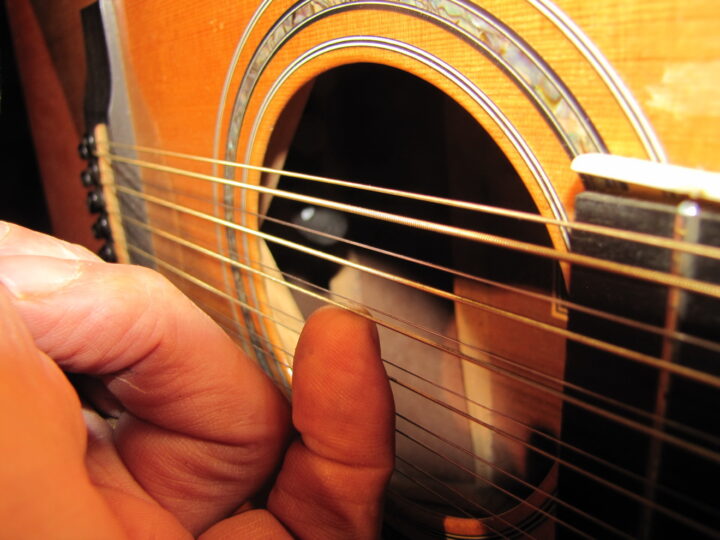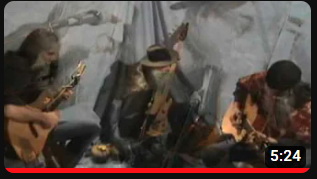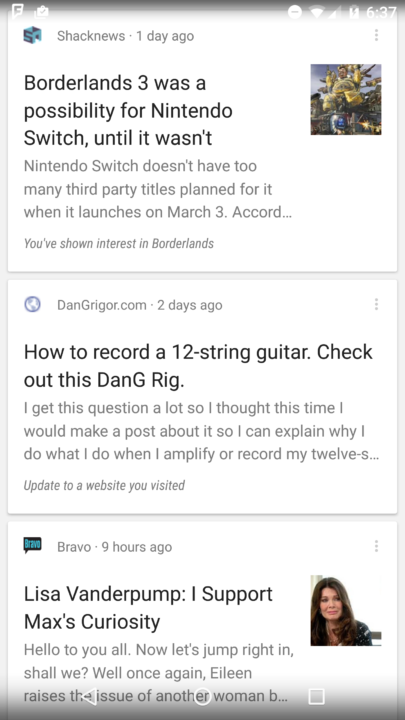I get this question a lot so I thought this time I would make a post about it so I can explain why I do what I do when I amplify or record my twelve-string guitar.
When I record, I prefer to use a Blumlein Pair. The mics that do that best are kind of expensive. With "affordable" mics - really, any high-quality mics that can go down to 30hz - I find this system works well. Place one up close in the sweet spot and one up high about 45 degrees to the front, stage right. I functionally use the same EQ and Comp/Lim as below but add it in post; recording raw is better. I might flavor the sound in my headphones temporarily to help me sing. then perfect it in post.
Something to listen to while you read: "Read To Me" from the Floating CD (new window)
Let's talk about the sweet spot for a second. How do you find it? It is the place where your guitar fits the song you're playing and sounds like... your guitar. The position moves slightly depending on the tone required. You can't find it while you are playing; you need a helper or you need to trial-and-error your way with the microphone. On my guitar it is just right and below of center of the soundhole and about a foot in front. For most of my songs, I position a mic near the bell, pointing past the hole toward the 9th fret or so. It shoots through the sound stream that is coming out of the hole. Therefore, it catches the sweet spot sound and shoots through and also captures the left-hand sounds. To me, that is a huge part of the sound of a guitar. The sound of fingers on strings. Shooting from the right instead of the left softens the extraneous left-hand sounds (back of the neck, squeaky slides etc.) and I can raise it up higher for more bass or lower it for a thinner sound. The other mic points at the sweet spot from up high, 8 to 10 feet depending on your ceiling height and floor surface. This mic captures the room sound for natural reverb and fullness. Move it around to find the best ambient sound for the room. 45 degrees to the right seems to work for me; higher for hard floors.
For YouTube and live situations this is my rig. We use two cameras for the same reason as we record with two mics. One camera captures the sound from up close or, preferably, raw from the board and one from the room. This lets you mix in some room noise in a live room full of people after you get home and adds a natural ambient reverb to the YouTube stuff.
I run the signal from the inserts on two channels from a mixer that sits on top, back to this amp which is FOH (front of house) for small rooms and monitor amp for bigger shows. I have a few different amps depending on which speakers and how many people there are. For a small club (less than 100) standard is a 400-800w FOH with the 200w as MON, two 3-way 15" speakers with horns on standard sticks and a single wedge or my IEMs. The guitar plugs into channel one through the XLR jack. The insert SENDS to the EQ, from there to the Comp/Lim, and RETURNS to the mixer then out to the amp. These are essential tools. I use the same setup on my voice. With a stereo EQ or a Stereo Compressor I use one side for my guitar and one for voice. One can never have too many Comp/Lims. I'll explain the settings I use below.
The 12-string is an interesting animal full of tones and overtones and harmonics and always slightly out of tune due to the nature of string vibrations. The 12-string in particular is full of overtones, which are created as tones are combined. The essence of 12-string is the combination of octave tones; harmony of those is found in the overtones. Pythagoras figured out that if you cut a string in half you get an octave, in thirds a perfect fifth, and so on. When you pluck a string is you define the length by which fret you are on. It sounds that note then, imagine a wave form, at rest it is flat. When you pluck it up you bend it a little, same if you pick down, tightening it, raising the pitch a microtone. When your finger lets go, the string wants to return to flat but because of tension it passes it and then, like a pendulum, it eventually gets flat or plucked again.
Therefore, in actuality, when you play a string it is sounding a blend of that wavering centered around the note. Pythagoras also figured out that when you play a string, it cuts itself in halves then thirds, fourths, fifths, and sixths. These overtones contribute to the note and waver in the same way.
We know that playing the harmonic at the twelfth fret cuts the string in half and sounds an octave higher and on the 12-string high-octave strings of the sets get an even higher octave overtone on top of that. The harmonic of the octave of the high G is 4 octaves away from the a G at the 3rd fret of the low octave string of the open 6th set.
In addition to all of that, the string actually splits itself into thirds again at the seventh; this creates an overtone sounding a fifth above of the actual tone. This overtone imposes a natural harmony as part of the note. These overtones are produced by the string. You can't stop it and therein lies the problem of recording or amplifying the 12-string. The fret you are holding, the string you are on, the length of it, how hard you pluck it, which other tones are playing, all of those things contribute to the sound of each note you play. The natural combination of those tones create overtones that waver in and out slightly and the distance from the listener defines how long they last. The natural vibration of string and the natural vibration of wood create the overall Tone of the Guitar. Manipulating all of that into a recording device is challenging.
Some overtones make a 12-string sound cheap, no matter what it is made of. Some guitars, 12-strings in particular, sound muddy up close. Using a sound hole pickup will exaggerate that problem, a piezo gets its sound from a vibrating crystal that picks up the vibration of the saddle, adding another layer and material to the texture of sound. Using a microphone usually creates feedback on a standard guitar played live, on a 12-string the effect is even worse. So what works for recording doesn't always work live through speakers with monitor wedges everywhere you turn.
I rely on a simple set of tools to manage the sound. I use an internal microphone instead of a "pickup." I can place it an inch below the sound hole and it sounds like my guitar does unplugged.
It gets the sum of the sound made by the wood, the strings, the air movement through the hole and even a little of my voice as I sing with it leaning against my chest. I really like everything about it except that it takes a battery and you practically have to remove it to change it. I found it on Stewart McDonalds website, a great source for parts and tools for musical instruments.
Next in the chain is the mixer. A good quality mixer set with a slight mid cut is usually all I need; you can take care of most feedback in the room with the mixer once I'm set up. From the insert on channel one I go to the left side of the Equalizer. I use a standard 9 band cheapie with gain controls and once I have the mixer set I use the gain and EQ to balance the signal sent to the compressor. With most 12s (and my guitar for sure) I need to cut the mids a touch to get rid of that hollow, cheap sound recordings often have. There are two places to make adjustments and, of course, every guitar and room is different. My rule of thumb is right around 250Hz and 800Hz. 800 seems to work on the high overtones and a slight cut there really helps. The 250 range is really important because of my voice. My guitar and my voice occupy the same range of frequencies right in the midrange where we sound most nasal when using a microphone. I cut here a little heavier to create a pocket for the vocal to sit in. However, look at the frequencies played by a 12 string tuned to D: 146.8Hz and 73.42Hz, 392 Hz and 196 Hz, 261.6 Hz and 130.8 Hz, 349.2 Hz and 174.6 Hz, 220.0 Hz and 293.7 Hz.
Also realize how much time you play the guitar (especially a 12) using open strings or frets around 5 and 7. The frequencies of those notes and overtones are right near that range, so a cut in that area or a small smile, if you will, around that frequency should eliminate that hollow 5-dollar guitar sound.
So the frequency of the position of 6th string 5th fret A is the same as the open A. As I said, I tune down a down a whole step so it's really a G for me and the range is between 200 and 400Hz. Using the less-is-more attitude I started cutting near those numbers and found that making a small smile around 250 did the trick.
Now realize that since you use those frets to tune practically all the same notes are available there in the same octaves or same frequencies. When those "mid" tones create too many overtones, that range gets muddy. Corresponding ranges in the low tones are lost below 20Hz and really below 40 is out of range for a lot of people. As I said above, my trial and error shows me that my high range is around the 800s. It's harder to hear the difference and less adjustment is necessary there. Above that is where the pick sound is and you can bump that a little if you use compression.
Bump around 10k for a touch for "presence" when with a drummer; not too much or you'll get scratchy pick noise. You'll need less reverb with that.
Remember no one can tell you how to equalize your room, your rig or your relationships. You have to like the sound and justify it any way you want. The numbers do give you a starting point and the experience of others is as valuable as your own if it happens to apply to you.
OK so now the tone is fine but the volumes of the individual strings are often not the same. Different strokes make different volumes - from pounding bass beats to little tiny whisper endings - the variable of volumes can muddy your sound. The Compressor/Limiter is the tool for the job.
There are plenty of places to go study the theory of these gizmos by people who are way smarter than me. So I'll give you a brief very general explanation and show you what I do. Only you can define your tone and again the numbers can give you a starting point from which you can experiment.
Simply said, I use a 3 to 1 ratio with a threshold near 30 and use attack to limit the "hit" and release to extend the sound.
A very basic explanation of what a Comp/Lim does is that it "balances" the volumes. In effect, you use it to lower the volume of the initial attack of the string (or drum or voice, etc.) so you can raise the volume of the quieter, longer-lasting actual tone of the note. The trick is to do it in such a subtle manner as not to wreck the dynamics of your style.
Here is how I set it and I set it for each room. Through trial and error using my Alesis 3630 compressor, I have found that a little less than 3-to-1 (2.34 to 1 in the studio) for the ratio works for me.
I start with threshold at 20, Ratio at 3, attack at 0 release at 0.
Switching to input uses the lights to check the level coming from the EQ and - using the gain on the EQ - adjust the input to max volume without redlining. Not overdriving the compressor is key to its function.
Switch back to output and adjust the threshold closer to 30 until you get a 5 or 6db cut on the loudest parts. Even in the dark of a soundcheck stage you can see the lights and adjust it until you get only 6 lights.
Listening to the room I adjust the attack to slightly mellow a big chord's "chunk." That click of the pick and big low string sound can overpower your mid tones and create muddy overtones. Taking a little off the top helps balance the volume across all the strings.
Release is set so that the hit lowers the volume and raises it back up based on this control. You decide how long before the chunk is released. I often have a short attack and a long release. In the right circumstances you can get a sort of sustain out of it, lending a subtle but natural sounding reverb. In effect, that means you won't have to add so much reverb which, to me, often sounds fake.
You can then use the output gain to bring your overall volume back up to no-redline levels.
The noise gate on the 3630 doesn't work for my 12 string; it cuts off too soon no matter what I set it to. I often use it on my vocal mic to limit room noise if I step back from the mic. Some rooms need a little delay or reverb, in particular when full of people. I add that on the mixer and set the guitar a tad deeper than the vocal.
Remember you are shaping the sound to best reflect the sound of your live guitar. Less adjustment is better; you should only have to find the muddy overtones and dial them out. Clarity across the strings is what you're after. That the High G is just as loud and articulate as the Low E... when you want it to be.
I have found that it really helps to understand what frequencies your songs use when trying to learn how to EQ. Understanding how a compressor works is a study in and of itself. An amazing tool that works like an ear drum to help you shape the sound to fit into an ear properly.
In a live situation and often in a controlled situation of your home recording studio it is going to be difficult or impossible to get your dream sound. Understanding that your ear is different than everyone else's is key. No matter how much time you spend dicking around with your tone folks are gonna hear it the way THEY hear it. Establishing your tone is a very personal thing involving compromises to get the room to sound good. You may have to give up some mid-tones for feedback control. To eliminate feedback you have to adjust the volume or adjust the EQ or reverb. There is the compromise. Don't kneejerk the volume up in a muddy room. Clarify the sound, get rid of the mud and the volume will feel louder.
The human ear is amazing, having two of them placed where they are on your head makes hearing a room an immersive environment. You hear in front, to the side, behind you, up in the attic, around the corner and your brain can locate that sound and place it in your mind as where it actually is.
Getting good sound is simply presenting the ear with enough clarity to cut through the din and letting the brain do the rest. Don't let an obsession with tone interfere with your song. Take a few minutes in soundcheck to get the best sound you can, then drop it and just play. Trust that your audience will hear more than just the sound coming from the speakers. A good song is a good song at any responsible volume. Ears do what they do. People can't hear tones below 20Hz but we feel them and it's uncomfortable. Anything over 100-110db starts to drive customers off the dance floor, back from the stage. Any louder than that and they wander right out the door of a small dive bar.
I hope this helps as a starting point for defining your personal style and tone. It has taken me a long time to find the natural sound of my guitar. Trying to fit my voice in the mix has been another journey. The numbers help, but only as a starting point. Have fun. Stay tuned. Play lots.





